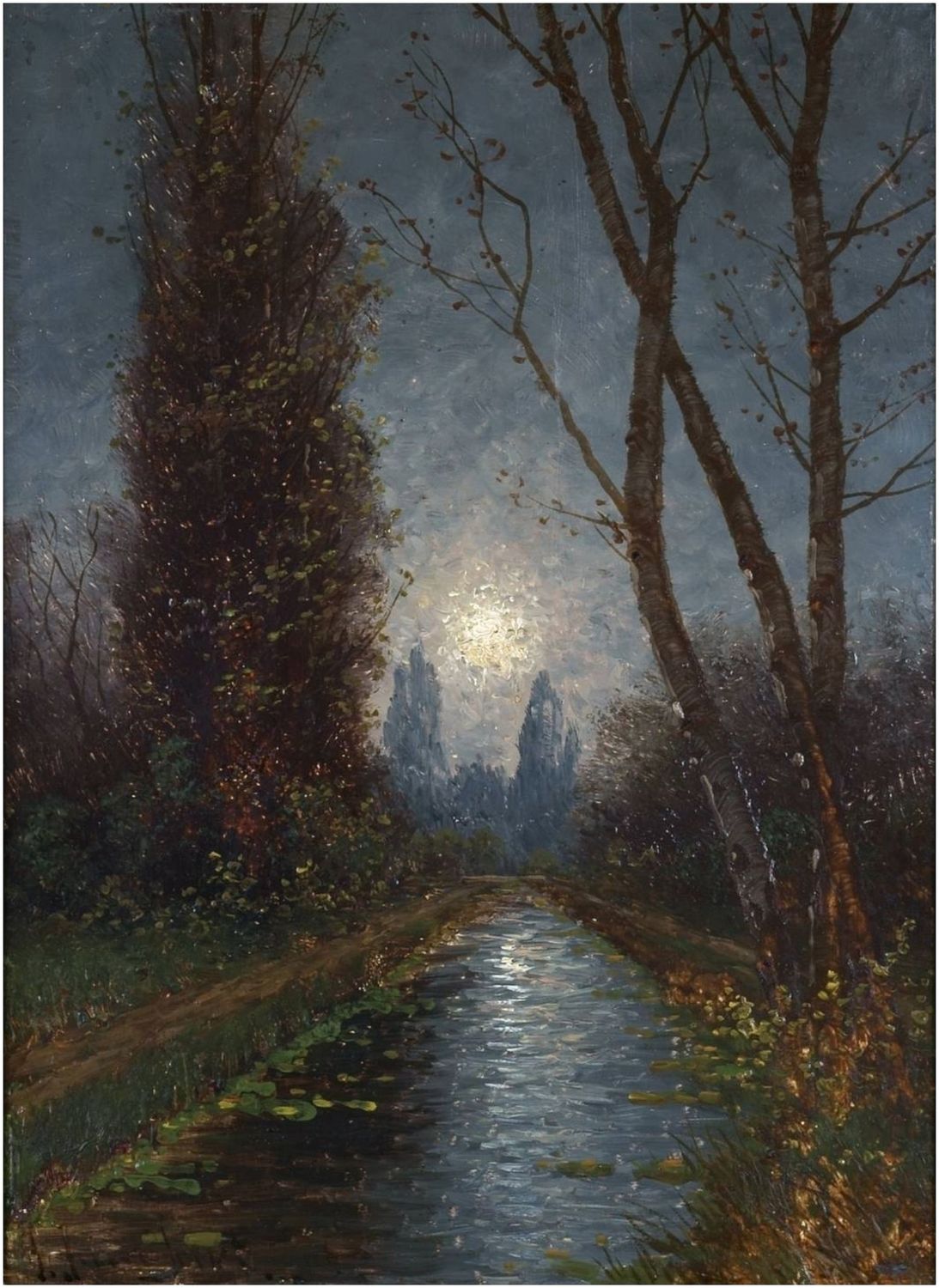Jungblut, Johann (1860-1912), Flusslandschaft mit Vollmond, um 1900
Johann Jungblut(1860 Saarburg - 1912 in Düsseldorf), Flusslandschaft mit Vollmond , um 1900. Öl auf Holz, 32 x 23 cm (Bildtafel), 45,5 x 37 cm (Rahmen), unten links mit „J. Jungblut.“ signiert.
- Rechte obere Ecke retuschiert, ansonsten in ausgezeichnetem Zustand und ansprechend gerahmt.
- Der Weg ins Licht -
Johann Jungblut weicht hier von seinem Motivkanon ab, um eine Szenerie zu veranschaulichen, die seine Landschaftsdarstellungen im Gegenlicht noch weit mehr auf die Lichtquelle beziehen. Wir sehen einen ins Bild hineinfluchtenden Kanal, der auf den hinter Wolken verborgenen Mond zuläuft, dessen Licht vom leicht bewegten Wasser reflektiert wird. Der Kanal wird zum leuchtenden Band und lässt das Mondlicht auch im Bildvordergrund präsent werden. Das Licht bricht sich aber nicht allein im Wasser, es findet sich auch auf den virtuos getupften schimmernden Blättern der Pappeln und Büsche und den weißen Stämmen der Birken am rechten Bildrand. Die gesamte Szenerie ist vom Glanz des kühlen Mondlichtes übergossen, der besonders eindrucksvoll aufleuchtet, indem sich die Vegetation ansonsten im Grünschwarzen verlieren. Einzig das äußere Blattwerk ist von Glanzlichtern erfüllt, was der Landschaft etwas Geheimnisvolles verleiht.
Dem angelegten Kanal entsprechend, wirkt die Vegetation angepflanzt und doch frei wachsend. Es mag sich um einen verwilderten Schlosspark handelt, wofür auch die sich an den Rändern des Kanals sammelnden Teichrosen sprechen, was der Szene zugleich einen märchenhaften Zug einschreibt.
Blicken wir das uns mit der Lichtquelle verbindende Leuchtband entlang, führt das Wasser jedoch nicht bis zum Horizont. Am Ende des Kanals erhebt sich abermals eine Vegetation, die farblich deutlich vom restlichen Bewuchs abgehoben und tonal dem Wasser und dem Himmel angepasst ist. Dadurch verbindet sie die irdische mit der himmlischen Sphäre. Gerade aufgrund ihrer einzig diffusen Erscheinung nimmt sie zugleich eine andere Form an: Die hohen Bäume links und rechts wirken wie die aufragenden Türme einer Kathedrale, zwischen denen die Fassade mit einem leicht dunkler gehaltenen Portal situiert ist. Im Mondlicht wird die Welt verklärt und offenbart einen über die Welt hinausführenden Sakralbau, auf den das Lichtband wie ein ausgerollter Teppich zuführt.
Aber handelt es sich überhaupt um das Licht des Mondes? Vermag der Mond mit einer derartigen Intensität durch die Wolkendecke zu strahlen? Für die Sonne hingegen erscheint die Landschaft zu dunkel. Jungblut hält die Identifikation der Lichtquelle bewusst in der Schwebe, um die Szene vom natürlichen Lauf der Dinge zu entkoppeln und ihr eine überzeitliche Transzendenz zu verleihen.
zum Künstler
Johann Jungblut, der heute zu den bekanntesten Landschaftsmalern der Düsseldorfer Schule zählt, war zunächst bei Villeroy & Boch in Mettlach tätig, was ihn künstlerisch jedoch nicht erfüllte. Fünfundzwanzigjährig zog er 1885 in die Kunstmetropole Düsseldorf, um sich dort der Malerei zu widmen.
In seinem Werk wurde er insbesondere von der holländischen Landschaftsmalerei inspiriert, die er auf mehreren Reisen nach Holland eingehend studierte. Zudem bereiste er die von der Düsseldorfer Schule als künstlerisches Motiv entdeckte norwegische Fjordlandschaft, die seinerzeit das nordische Pendent zum Sehnsuchtsortort Italien bildetet.
Jungblut entwickelte einen die Romantik mit den Farbatmosphären des Impressionismus verbindenden charakteristischen Stil, der ihn zu einem vielgefragten Künstler machte.
Seine Werke signierte er mitunter mit dem Pseudonym J. M. Sander. Er war Vater des Bildhauers Emil Jungblut und der Maler Hans und Walter Jungblut.

